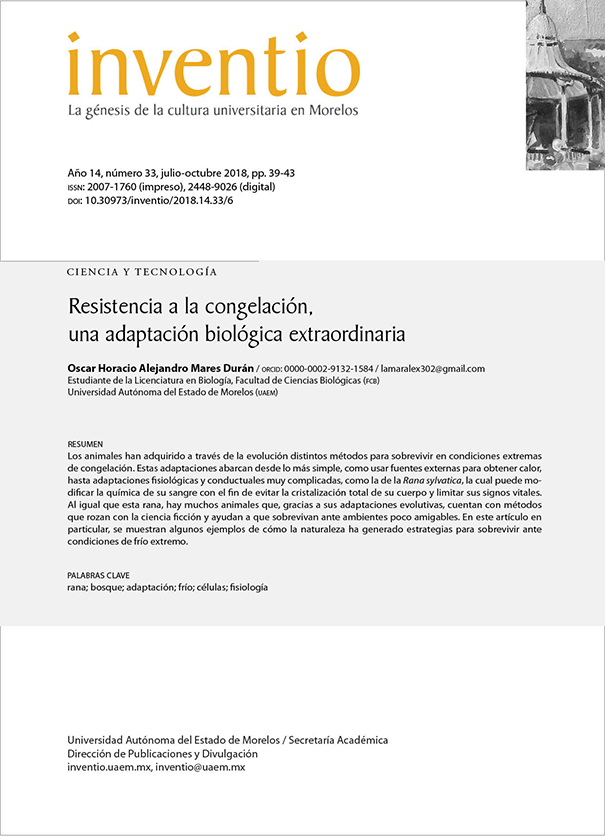Resistencia a la congelación, una adaptación biológica extraordinaria
Palabras clave:
rana, bosque, adaptación, frío, células, fisiologíaResumen
Los animales han adquirido a través de la evolución distintos métodos para sobrevivir en condiciones extremas de congelación. Estas adaptaciones abarcan desde lo más simple, como usar fuentes externas para obtener calor, hasta adaptaciones fisiológicas y conductuales muy complicadas, como la de la Rana sylvatica, la cual puede modificar la química de su sangre con el fin de evitar la cristalización total de su cuerpo y limitar sus signos vitales. Al igual que esta rana, hay muchos animales que, gracias a sus adaptaciones evolutivas, cuentan con métodos que rozan con la ciencia ficción y ayudan a que sobrevivan ante ambientes poco amigables. En este artículo en particular, se muestran algunos ejemplos de cómo la naturaleza ha generado estrategias para sobrevivir ante condiciones de frío extremo.
Citas
Abboud, J. y Storey, K. “Novel control of lactate dehydrogenase from the freeze tolerant wood frog: role of posttranslational modifications”, PeerJ, vol. 1, 2013, pp. e12, DOI: 10.7717/peerj.12
Czikoa, P., DeVries, A., Evanse, C. y Chengb, C. “Antifreeze protein-induced superheating of ice inside Antarctic notothenioid fishes inhibits melting during summer warming”, Proceedings of the National Academy of Sciences of the United States of America, vol. 111, núm. 40, 2014, pp. 14583-14588, DOI: 10.1073/pnas.1410256111
Do Amaral, M., Lee Jr, R. y Costanzo, J. “Enzymatic regulation of glycogenolysis in a subarctic population of the wood frog: implications for extreme freeze tolerance”, PLoS ONE, vol. 8, núm. 11, 2013, pp. e79169, DOI: 10.1371/journal.pone.0079169
Gao, D. y Critser, J.K. “Mechanisms of cryoinjury in living cells”, ILAR journal, vol. 41, núm. 4, 2000, pp. 187-196, https://bit.ly/2PuHHow
Glanville, E., Murray, S. y Seebacher, F. “Thermal adaptation in endotherms: climate and phylogeny interact to determine population-level responses in a wild rat”, Functional Ecology, vol. 26, núm. 2, 2012, pp. 390-398, DOI: 10.1111/j.1365-2435.2011.01933.x
Hengherr, S., Worland, M.R., Reuner, A., Brúmmer, F. y Schill, R. “High‐temperature tolerance in anhydrobiotic tardigrades is limited by glass transition”, Physiological and Biochemical Zoology, vol. 82, núm. 6, 2009, pp. 749-755, DOI: 10.1086/605954
MacDonald, J., Degenhardt, T., Baynes, J. y Storey, K. “Glycation of wood frog (Rana sylvatica) hemoglobin and blood proteins: in vivo and in vitro studies”, Cryobiology, vol. 59, núm. 2, 2009, pp. 223-225, DOI: 10.1016/j.cryobiol.2009.06.008
McGill, L., Shannon, A., Pisani, D., Féliz, M., Ramlov, H., Dix, I., Wharton, D. y Burnell, A. “Anhydrobiosis and freezing-tolerance: adaptations that facilitate the establishment of Panagrolaimus nematodes in polar habitats”, PLoS ONE, vol. 10, núm. 3, 2015, pp. e0116084, DOI: 10.1371/journal.pone.0116084
Myhrvold, C., Stone, H. y Bou-Zeid, E. “What is the use of elephant hair?”, PLoS ONE, vol. 7, núm. 10, 2012, pp. e47018, DOI: 10.1371/journal.pone.0047018
Ploomi, A., Kivimagi, I., Kruus, E., Sibul, I., Jogar, K. y Metspalau, L. “Seasonal cold adaptation dynamics of some carabid beetle species: Carabus granulatus, Pterostichus oblongopunctatus and Platynus assimilis”, Forestry Studies, vol. 57, núm. 2, 2012, pp. 90-96, DOI: 10.2478/v10132-012-0007-3
Schwab, I. “An icy stare”, British Journal of Ophthalmology, vol. 98, núm. 10, 2005, p. 1236, DOI: 10.1136/bjo.2005.074336
Terrien, J., Perret, M. y Aujard, F. “Behavioral thermoregulation in mammals: a review”, Frontiers in Bioscience, vol. 16, núm. 4, 2011, pp. 1428-1444, DOI: 10.2741/3797
Williams, C., Hagelin, J. y Kooyman, G. “Hidden keys to survival: the type, density, pattern and functional role of emperor penguin body feathers”, Proceedings of the Royal Society B, vol. 282, núm. 1817, 2015, pp. 2015-2033, DOI: 10.1098/rspb.2015.2033

Publicado
Cómo citar
Número
Sección
Licencia

Esta obra está bajo una licencia internacional Creative Commons Atribución-NoComercial 4.0.
Esta revista proporciona acceso abierto inmediato a su contenido, con base en el principio de ofrecer al público un acceso libre a las investigaciones para contribuir a un mayor intercambio global de conocimientos. Se distribuye bajo una licencia Creative Commons Reconocimiento-NoComercial 4.0 Internacional License.

